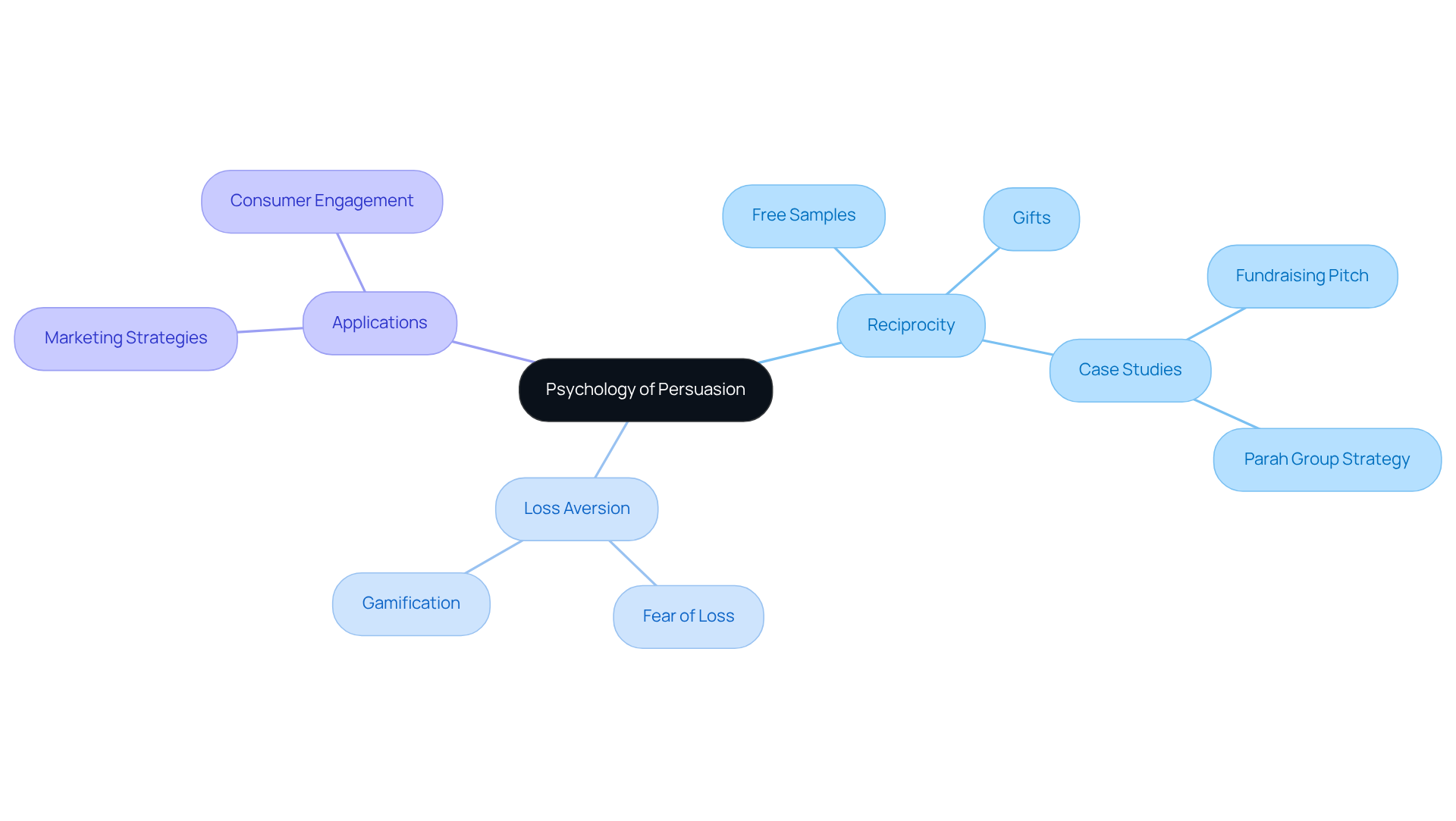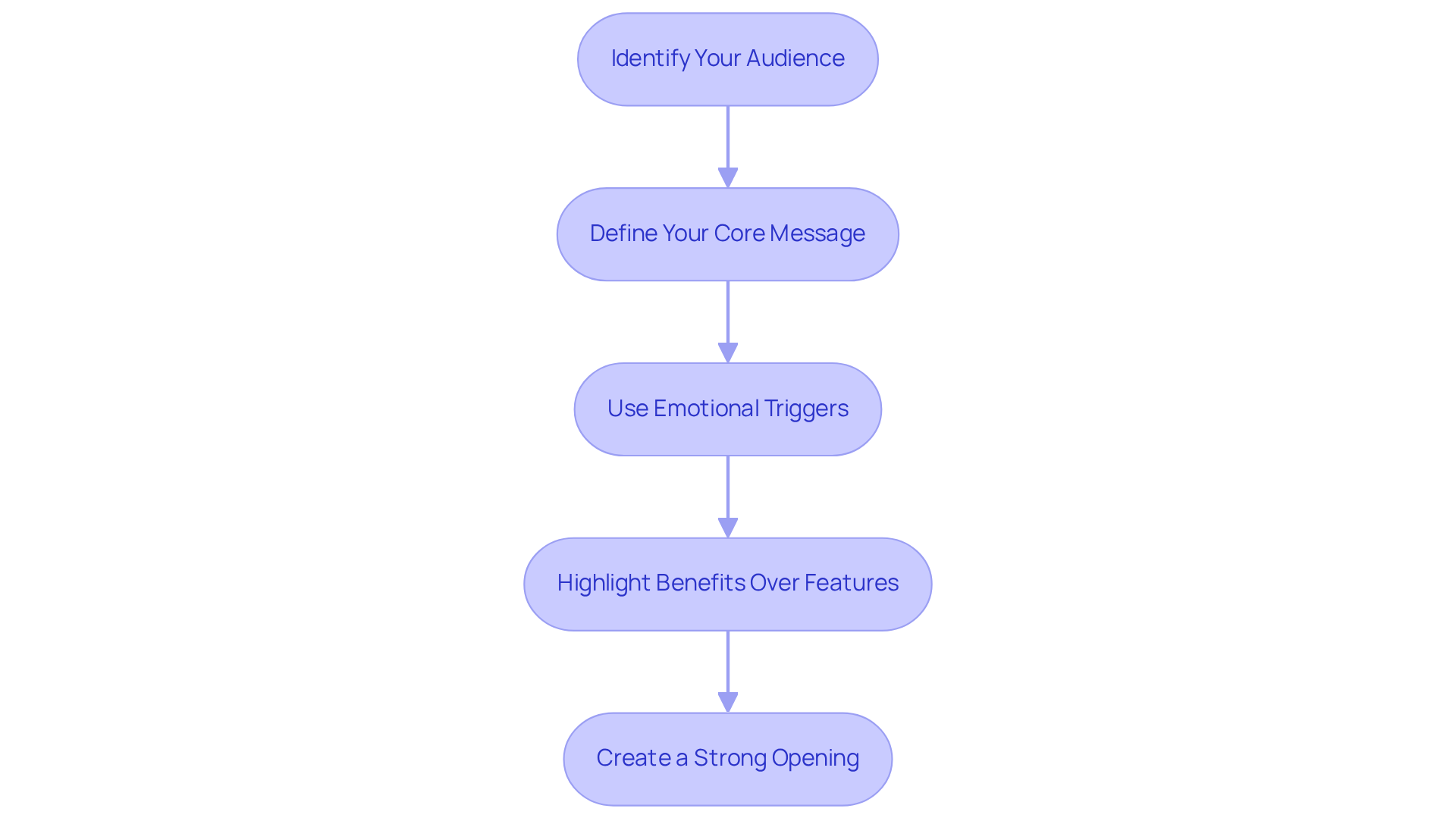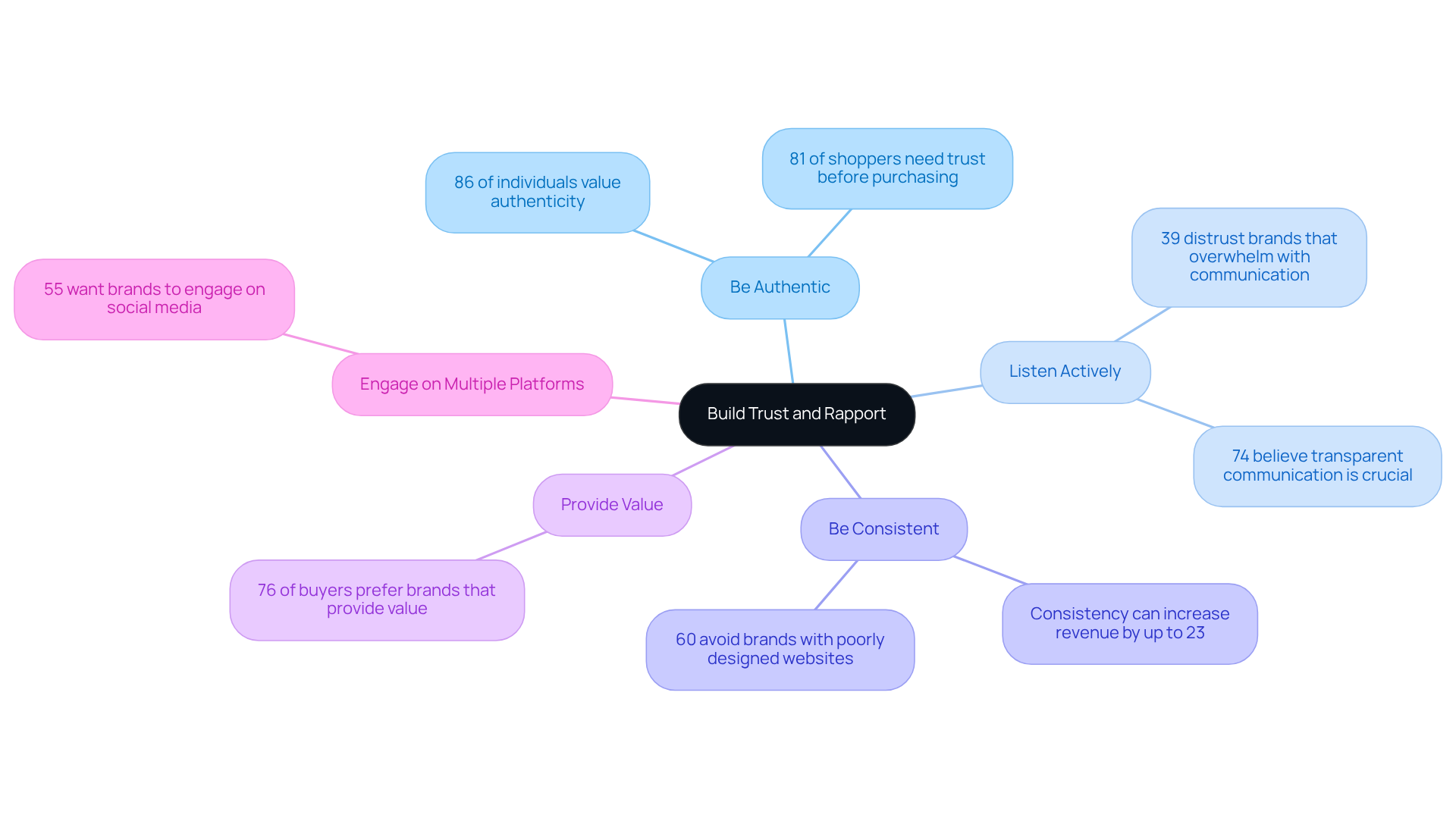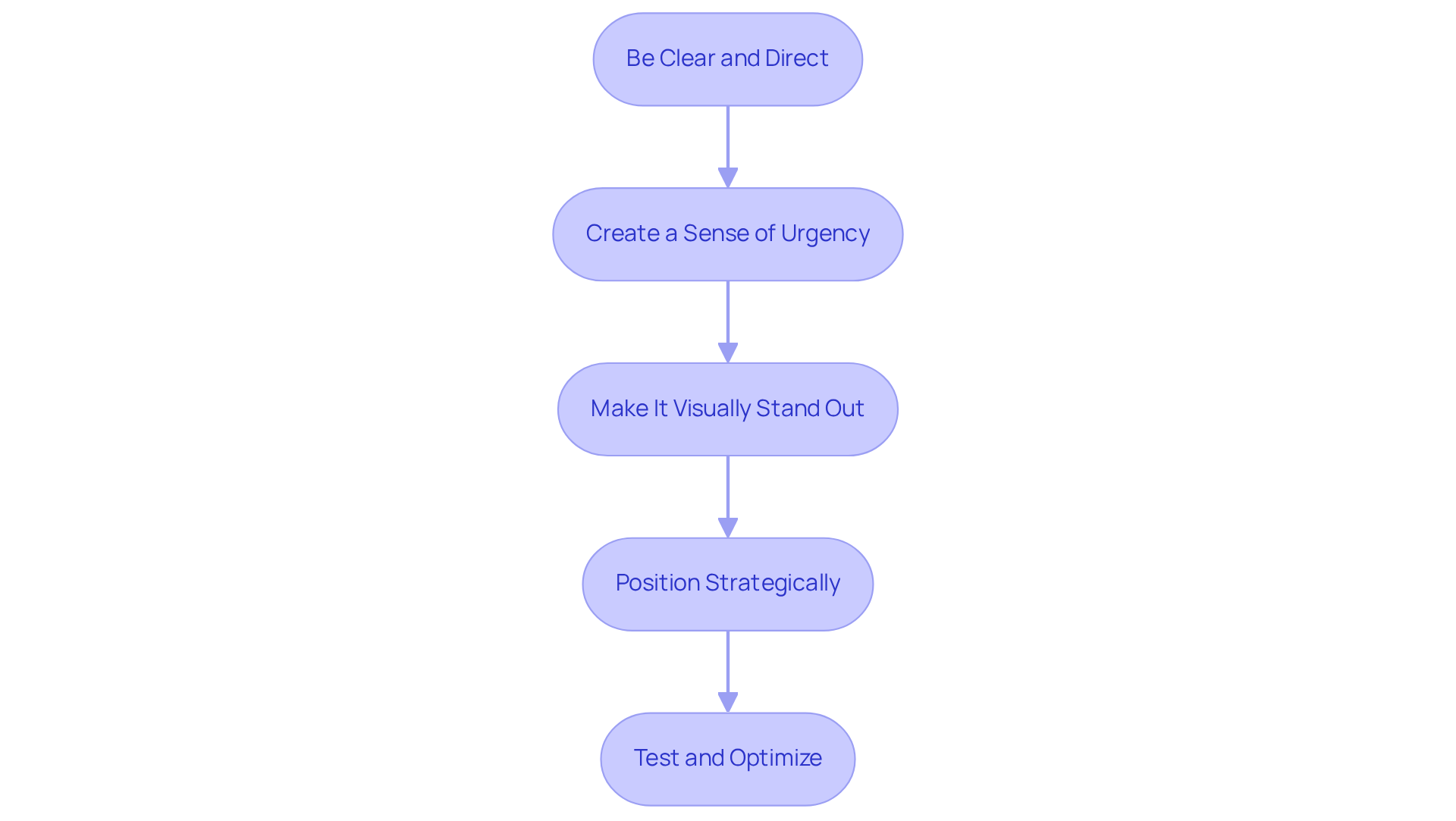
Overview
The article delineates four essential steps to convincingly motivate individuals to take action. It underscores the significance of:
- Grasping psychological principles
- Crafting persuasive messages
- Establishing trust
- Executing effective calls to action
Each of these steps is bolstered by strategic approaches, such as leveraging the principle of reciprocity to amplify engagement and ensuring that calls to action are both clear and urgent. Collectively, these strategies not only foster stronger relationships but also drive the desired responses from the audience, reinforcing the necessity of implementing these techniques.
Introduction
Understanding the intricacies of human behavior is paramount to effective persuasion, particularly in a landscape where opinions and decisions are significantly shaped by psychological principles. This article explores four essential steps that not only enhance persuasive communication but also empower individuals to inspire action and forge meaningful connections. Yet, what occurs when traditional methods prove inadequate? How can one adapt to the dynamic realm of influence?
Understand the Psychology of Persuasion
Understanding the psychological principles that drive human behavior is crucial for mastering how to convince people to do something effectively. One of the most powerful concepts is reciprocity, which suggests that individuals are more inclined to respond positively when they feel indebted to someone. This principle can be utilized by providing benefits upfront—such as free resources or insightful content—which can significantly improve the chances of a positive response. For instance, [Parah Group](https://parahgroup.com) implemented strategies like introducing free gifts over a certain cart size, which not only provided value but also encouraged larger purchases.
Recent studies indicate that reciprocity plays a vital role in consumer behavior. When companies offer , they leverage the reciprocity principle, causing recipients to experience a sense of duty to return the favor, frequently by making a purchase. This strategy has been shown to increase conversion rates dramatically, with some reports indicating that online reviews can boost conversion rates by up to 270%.
Case studies further illustrate the effectiveness of reciprocity. A fundraising pitch that began with 'I'm a student' saw contributions increase by 450%, demonstrating how establishing a connection can prompt generosity. Additionally, the principle of loss aversion—where the fear of losing something is twice as powerful as the desire to gain—can be effectively combined with reciprocity. By emphasizing what consumers stand to lose if they do not act, companies can motivate quicker decisions. For instance, the implementation of gamified progress bars for free shipping thresholds helped a cleaning product brand increase their average order value by 80%.
Integrating these insights into your marketing approach can create a compelling narrative that resonates with your audience, ultimately driving engagement and conversions. By understanding and applying the principle of reciprocity, along with other psychological techniques, you can enhance your persuasive skills and learn how to convince people to do something, ultimately building stronger relationships with potential customers.

Craft a Compelling Message
To craft a compelling message, follow these steps:
- Identify Your Audience: Understand who you are speaking to. Tailor your language, tone, and content to their preferences and pain points. Parah Group emphasizes the importance of knowing your audience to maximize conversion rates, as this understanding allows for more effective communication and alignment with customer needs. For instance, in a case study with a $30M clothing line, understanding the target demographic led to a redesign that significantly improved engagement.
- Define Your Core Message: What is the main point you want to convey? Keep it clear and concise. A well-defined message is crucial in CRO, as it helps in creating targeted strategies that resonate with potential customers. In the case of Grab Green, a $15M cleaning product brand, a targeted message on sustainability helped align their offerings with buyer principles.
- Use Emotional Triggers: Incorporate stories or scenarios that evoke emotions. Research shows that 49% of consumers make impulse purchases when presented with , highlighting the power of emotional engagement. Parah Group's case studies demonstrate how emotional connections, such as storytelling in marketing campaigns, can significantly enhance customer engagement and drive conversions.
- Highlight Benefits Over Features: Focus on how your suggestion will improve the audience's situation rather than just listing features. Businesses that tailor their offerings to customer segments generate 10% to 15% more revenue, demonstrating the effectiveness of benefit-driven messaging. This method is crucial to Parah Group's CRO plans, which focus on profitability and sustainable growth, as demonstrated in their collaboration with STRNG Seeds, where highlighting product advantages resulted in higher average order amounts.
- Create a Strong Opening: Start with a hook that grabs attention—this could be a surprising fact, a question, or a bold statement. For instance, emails with personalized subject lines are 26% more likely to be opened, emphasizing the importance of a captivating start. Parah Group's successful case studies often begin with compelling narratives that draw in the audience and set the stage for conversion.
By following these steps on how to convince people to do something, you can create a message that not only informs but also inspires action, using emotional triggers to enhance marketing effectiveness. Additionally, consider the insights from Stephen R. Covey, who noted that "communication is the real work of leadership," reinforcing the importance of effective messaging in driving growth and profitability.

Build Trust and Rapport with Your Audience
To build trust and rapport, consider the following strategies:
- Be Authentic: Sharing genuine thoughts and experiences fosters a deeper connection. Studies indicate that 86% of individuals feel when choosing which companies to endorse, emphasizing the significance of staying true to your principles. Moreover, 81% of shoppers indicate that trust is crucial before making a purchase, reinforcing the link between authenticity and trust in purchasing decisions.
- Listen Actively: Valuing your audience's opinions is essential. Actively listening and responding thoughtfully to their concerns not only enhances relationships but also demonstrates respect. Statistics reveal that 39% of consumers will distrust a company that overwhelms them with communications, underscoring the necessity for meaningful engagement. Furthermore, 74% of customers believe transparent communication is more important now than before the pandemic, emphasizing the role of active listening in building trust.
- Be Consistent: Consistency in messaging and actions builds reliability. When your communication aligns with your values and promises, it reinforces trust. A strong visual identity and consistent marketing can increase revenue by up to 23%, showcasing the financial advantages of maintaining a coherent image. It's also essential to recognize that 60% of shoppers are likely to steer clear of companies with poorly designed or unprofessional websites, emphasizing the importance of user experience in establishing trust and rapport.
- Provide Value: Offering insights, tips, or resources that genuinely help your audience positions you as a helpful authority rather than just a salesperson. Brands that elicit strong emotional ties find that 76% of buyers are more inclined to purchase from them, highlighting the significance of providing value.
- Engage on Multiple Platforms: Interacting with your audience through various channels, such as social media and email, strengthens relationships. 55% of individuals express a desire for brands to interact with them directly on social media, indicating a shift towards interactive communication.
By implementing these strategies, you can create a strong foundation of trust that demonstrates how to convince people to do something effectively.

Implement Effective Calls to Action
To implement effective calls to action, adhere to the following guidelines:
- Be Clear and Direct: Utilize straightforward language that instructs the audience precisely on what to do, such as 'Sign up now' or 'Get your free trial.' Clear directives eliminate confusion and encourage immediate action.
- Create a Sense of Urgency: Incorporate phrases like 'limited time offer' or 'act now' to prompt quicker responses. Statistics indicate that urgency can significantly enhance buyer response rates; email marketing campaigns featuring a call to action (CTA) have been shown to .
- Make It Visually Stand Out: Employ contrasting colors, larger fonts, or buttons to draw attention to your CTA. Research indicates that red buttons consistently outperform green ones, as the color red is associated with urgency and prompts action, leading to higher conversion rates.
- Position Strategically: Place CTAs in locations where they are most likely to be seen, such as at the end of a compelling message or within engaging content. CTAs embedded in text blogs can increase conversion rates by up to 121%, demonstrating the effectiveness of strategic placement.
- Test and Optimize: Regularly test different CTAs to ascertain which ones perform best. Employ A/B testing to refine your approach based on data, ensuring that your CTAs evolve with consumer preferences and behaviors.
By adhering to these guidelines, you can discover how to convince people to do something with CTAs that effectively convert interest into action, driving the results you desire.

Conclusion
Mastering the art of persuasion is fundamentally rooted in understanding the psychological principles that govern human behavior. By leveraging concepts such as reciprocity, emotional engagement, and effective messaging, individuals and businesses can significantly enhance their capacity to persuade. The journey toward influence commences with an acknowledgment of the intricate dynamics of human interaction, utilizing these insights to cultivate deeper connections.
Key strategies, including crafting a compelling message, building trust, and implementing effective calls to action, illustrate their profound impact on persuasion. Identifying the audience, highlighting benefits, and creating urgency are essential components that contribute to successful communication. Furthermore, the significance of authenticity and active listening cannot be overstated; these elements lay a critical foundation of trust necessary for influencing decisions.
Ultimately, the ability to persuade is not merely about tactics but about forging meaningful relationships and delivering value. By applying these insights and techniques, individuals and organizations can transform their approach to persuasion, inspiring action and driving results. Embracing these principles leads to more impactful interactions, whether in marketing, leadership, or everyday communication, underscoring the vital role that effective persuasion plays in achieving desired outcomes.
Frequently Asked Questions
What is the principle of reciprocity in persuasion?
The principle of reciprocity suggests that individuals are more inclined to respond positively when they feel indebted to someone. This can be leveraged by providing benefits upfront, such as free resources or insightful content.
How can companies utilize the principle of reciprocity?
Companies can utilize reciprocity by offering free samples or gifts, which creates a sense of obligation in recipients to return the favor, often by making a purchase. This strategy can significantly improve conversion rates.
What impact do free samples have on consumer behavior?
Free samples can lead to a sense of duty to reciprocate, resulting in increased purchases. Studies indicate that this can boost conversion rates dramatically, with some reports showing increases of up to 270% from online reviews.
Can you provide an example of how reciprocity has been effectively used?
One example is a fundraising pitch that started with the phrase 'I'm a student,' which resulted in a 450% increase in contributions, demonstrating how establishing a connection can encourage generosity.
What is loss aversion and how does it relate to persuasion?
Loss aversion is the principle that the fear of losing something is twice as powerful as the desire to gain. This can be combined with reciprocity to motivate quicker decisions by emphasizing what consumers might lose if they do not act.
How did gamified progress bars impact consumer behavior?
The implementation of gamified progress bars for free shipping thresholds helped a cleaning product brand increase their average order value by 80%, showing the effectiveness of combining loss aversion with reciprocity.
How can understanding these psychological principles enhance marketing strategies?
By integrating the principles of reciprocity and loss aversion into marketing approaches, businesses can create compelling narratives that resonate with their audience, driving engagement and conversions while building stronger relationships with potential customers.
FAQs











